Choosing between acacia and bamboo cutting boards can be perplexing. In fact, the decision is as puzzling to home chefs as it is to professional food preparers. But not any longer! Today, I will guide you through picking the ideal one for your home – and it’s easy!
A wood cutting board is a pivotal part of any kitchen. It is the workhorse of meal preparation, used for slicing and dicing fruits and vegetables. So, it makes sense to pick the best!
And herein, I’ll dig deep into each of these wood cutting board materials. I’ll look at the pros and cons of each and the key differences between the two. From there, it will be easy to know which of the two is ideal for you.
JUMP TO : Quick Overview | Acacia Cutting Board | Bamboo Cutting Board | Acacia and Bamboo Cutting Board Differences | Bottomline |
- Acacia wood has more favorable qualities for a cutting board than bamboo
- Bamboo is more affordable since it grows faster and needs less labor.
- Acacia is knife-friendlier than bamboo, but buy end and face grain for more knife protection.
- Following the manufacturer’s instructions is the key to getting the best from your chopping board.
Quick Overview – Table Comparison
| Parameter | Acacia Cutting Board | Bamboo Cutting Board |
| Toxicity | Non-toxic | Non-toxic |
| Porosity | Low | Moderately low |
| Aesthetics | More natural and rustic look | More polished and refined feel |
| Substance resistance | Resists water, mildew, and rot | Has antimicrobial properties but doesn’t resist water as effectively. |
| Silica content | Low silica content | The high silica content is dangerous for knives |
| Dishwasher compatibility | Not dishwasher-safe | Not dishwasher-safe |
| Maintenance | Low maintenance | Moderately low maintenance |
Acacia Cutting Boards – Explained
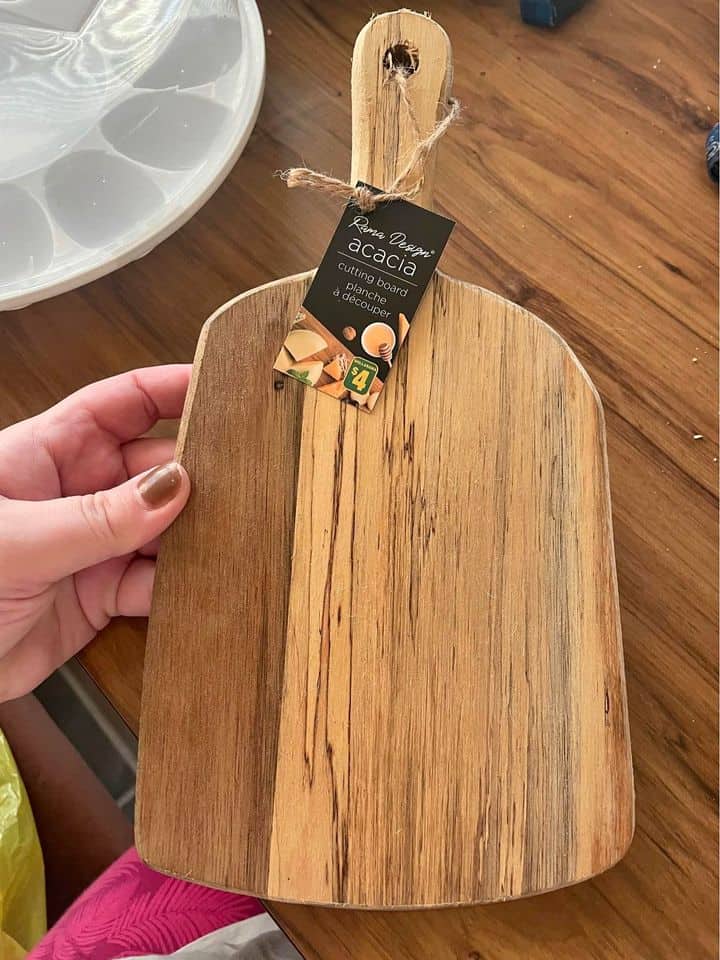
Acacia cutting boards are quickly gaining popularity. Perhaps that’s the reason you’re here!
And it’s completely fine!
Acacia is a type of hardwood, mostly found in Africa and Australia. It is highly durable and comes in over 1350 species.
1350 is a lot, and it means a greater diversity in performance, right?
But don’t panic yet!
Most acacia wood chopping boards have many of the desirable traits you want in wooden cutting boards.
Here are the pros and cons of acacia wood cutting boards:
Pros:
- Hard & Durable: Acacia is a hardwood. It’s one of the hardest and most durable out there. It won’t crack or splinter, even after years of use.
- Workability: It’s a perfect wood for cutting boards as it’s easy to work with. Its grain structure is smooth and balanced, allowing for clean-cut edges.
- Substance Resistance: Acacia wood is naturally resistant to water, mold, and rot. These are the main enemies of cutting boards, so that’s a big plus.
- Great Aesthetics: Obviously, Acacia is an attractive and colorful wood with different shades of yellow, brown, and red. It adds to the décor of any kitchen.
- Low Maintenance: The oilier surfaces make them naturally resistant to water and other elements. Plus, with proper care, an Acacia cutting board can last for many years.
Cons:
- Price: Acacia boards are slightly more expensive compared to most other options.
- Weight: These cutting boards are made from hardwood and tend to be quite heavy.
Bamboo Cutting Boards – Explained
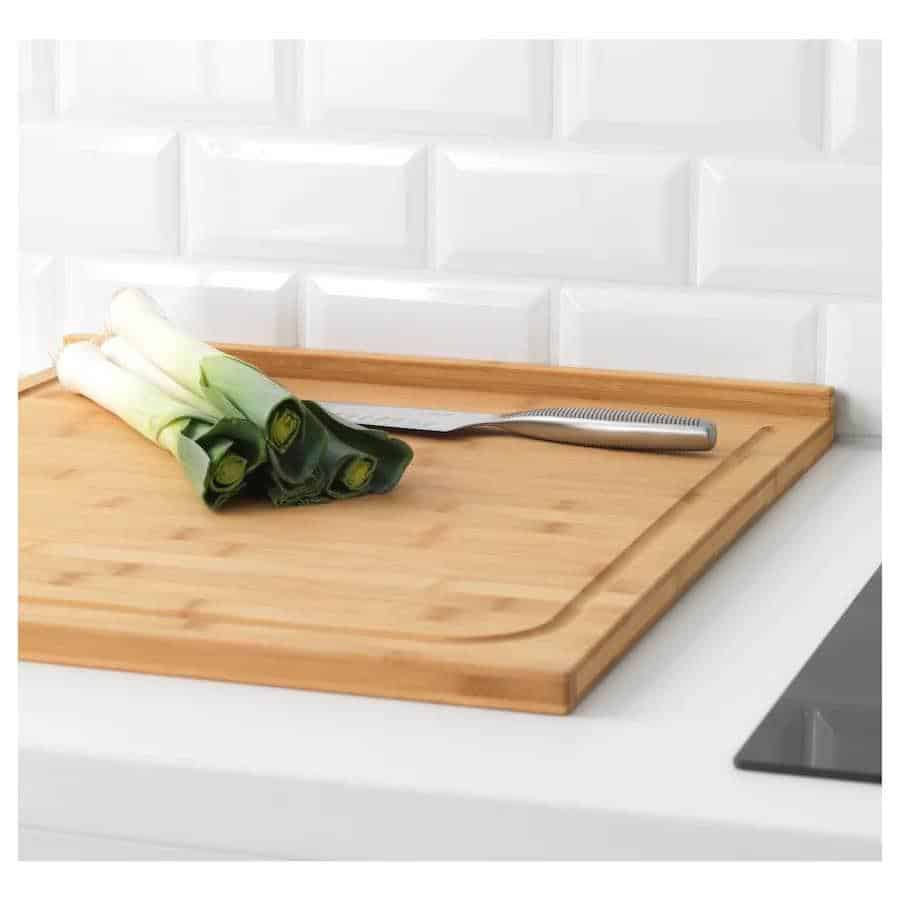
Bamboo cutting boards are another popular option.
In fact, if you’re an eco-conscious person, it’s one of the best materials for your home furniture and other equipment.
But does it make a nice option for wooden cutting boards?
To some extent – it does!
A bamboo wood cutting board is an aesthetically pleasing material with many admirable traits.
Here are the pros and cons of a bamboo cutting board:
Pros:
- Environmentally friendly: Bamboo is one of the materials available with the best sustainability. It is a fast-growing grass and needs less water compared to other trees.
- Easily Available: It’s the fastest growing plant on earth according to Guinness world records – growing at up to 91 cm (2.91 feet) per day or 1.5 inches per hour! It may grow before your eyes!
- Lightweight: The bamboo cutting board is much lighter than its hardwood counterparts. Bamboo is 40 pounds per cubic feet, similar to oak. The lightweight structure makes bamboo boards easy to carry around and store in the kitchen.
- Antimicrobial: Bamboo has natural antimicrobial properties, making it resistant to fungi, bacteria, and other food-borne illnesses.
- Cost-Effective: The bamboo cutting board is much less expensive than hardwood alternatives like Acacia wood cutting board. You could get a wooden cutting board for less than $5!
Cons:
- High Silica Content: Bamboo has a naturally high silica content. This will cause the blade of your knife to dull quickly, reducing its lifespan.
- Limited Substance Resistance: Bamboo’s water resistance comes from its density. It doesn’t contain natural oils, which means exposed long enough, it can give in to water damage.
- Fuzzy Splitters: It’s not one of the hardwoods. In fact, bamboo is a soft grass. So, it can easily split and crack if it’s not handled with care.
Related Read: Acacia Vs. Teak Cutting Board – Here’s What To Buy!
7 Key Differences Between Acacia and Bamboo Cutting Boards
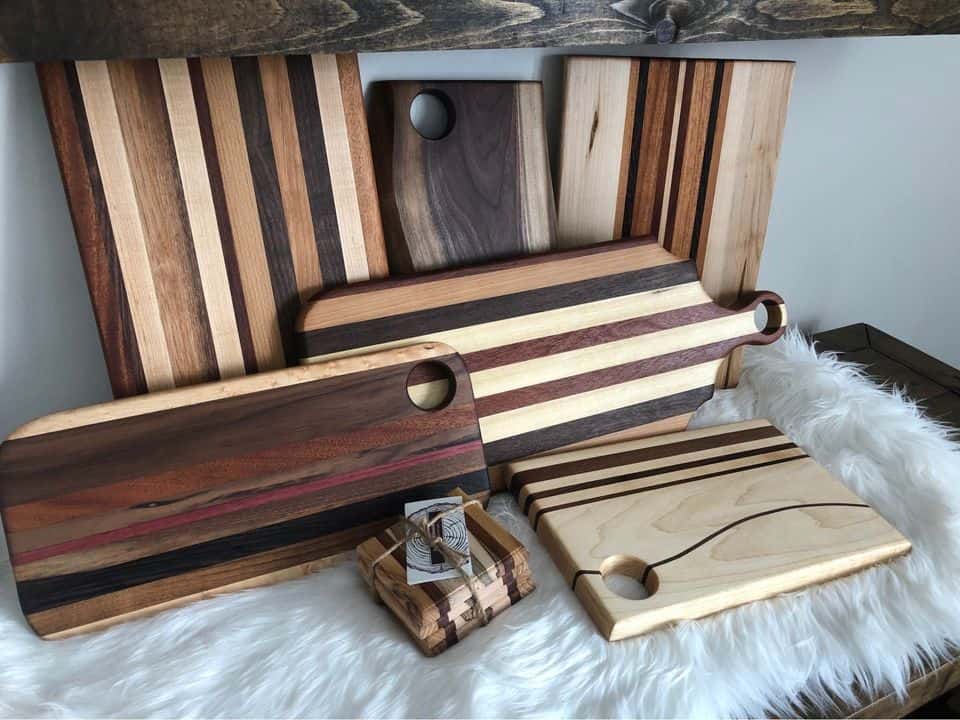
Now that we’ve looked at the pros and cons of each cutting board material, it’s time to examine the key differences between Acacia and Bamboo cutting boards.
Durability
We all want durability when buying a wood cutting board. And yes, durability is one area where the two materials – acacia and bamboo – differ significantly.
So, which one is more durable?
The answer is Acacia!
Being a hardwood, it’s much sturdier and resistant to wear and tear than bamboo, which is a soft grass.
Porosity
Both acacia and bamboo are porous. After all, all plant-based materials are.
But then again, the porosity extent differs from one material to the other.
And here – bamboo carries the day.
I mean, acacia wood cutting boards are slightly more porous than bamboo. So, holding all other factors constant, it can absorb more liquids than bamboo. But that’s not the case because acacia wood has more natural oil.
Substance Resistance
Water, rot, and mold are enemies of your kitchenware. So, you want a material that can resist as many of these elements as possible.
And in this case, Acacia wood cutting boards take the crown again. It has more oil, meaning better resistance to water, rot, and mold.
As for bamboo, it has natural antimicrobial properties but doesn’t contain the same amount of oil as Acacia. So, it can still be affected by water if left in contact for a long time.
Color Compatibility
You obviously don’t want a piece that doesn’t match your kitchen décor. I mean, this is not only distracting but also ruins the entire look of your kitchen.
So, which of the two materials is better in this case?
Well, it depends on your preference!
Acacia wood has a more natural and rustic look, so it may fit better in some kitchens and dining rooms. On the other hand, bamboo gives off a more polished and refined feel. It’s up to you to choose what works for your kitchen.
Maintenance

Source: America’s Test Kitchen
Maintaining your wooden cutting board is hard work, so it has to be as easy as possible.
On this one, Acacia wood cutting boards are winners again, thanks to their more natural oils. More oil means it will naturally repel water, mold, and rot.
Of course, bamboo can resist all of the above elements. But that’s because it’s dense. So, afforded enough time, it can let elements like water seep in more easily than acacia wood, separating the two!
Cost
Of course, financial considerations largely dictate the type of wooden cutting board you’ll buy. Even if a cutting board has everything you need, the inability to pay for it is a deal breaker.
On cost-friendliness, bamboo has the upper hand!
It costs way less money compared to acacia wood. As the world’s fastest-growing plant, bamboo takes less labor and time to produce.
In fact…
Once the plant is 60 days old, it can’t grow taller or wider! That’s unlike Acacia trees which take years to mature.
Knife Friendliness
We all want the best for our knives. So, what are the knife-friendliness differences between Acacia and Bamboo boards?
To get the conclusion here, we examine two aspects;
- The material hardness
- Silica content
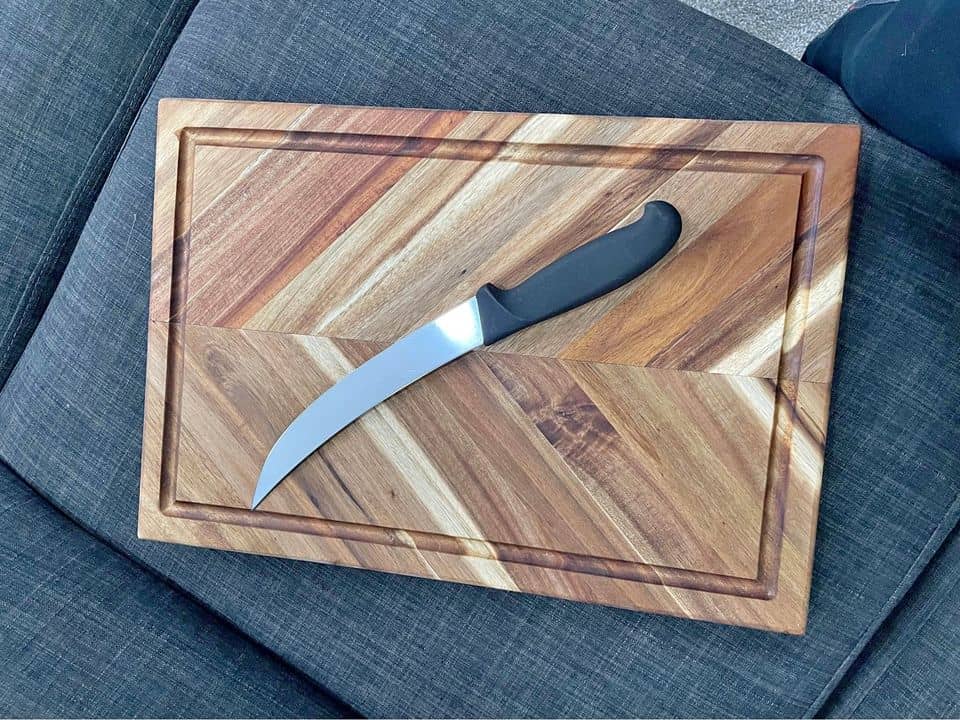
Material Hardness
Obviously, acacia wood is harder than bamboo. That means it can be a bit tough on your knives when cutting. The hard surface can damage the blade’s edge and make it dull faster.
Silica Content
While bamboo is softer than Acacia, it contains more silica. And that’s, again, another bad news for your knives. Silica is abrasive and can also wear down the blade’s edge.
So, which one of the two materials is knife friendly?
Well, I’d again go with acacia.
But this time, it comes with a condition.
The hardness of acacia wood means more durability for the cutting board, which somewhat offsets the knife’s damage.
But to keep it safer for your knives, go for end or face grain instead of edge or long grain. That way, you’ll get the same durability but with lesser damage to the edge.
And, of course, sometimes it’s not about the cutting board. At times, we just need to invest in better knives!
Related Read: Is Teak Wood Good for Cutting Boards?
Wrapping It Up!
Both acacia and bamboo cutting boards are great options. But for a more durable, knife-friendly, and substance-resistant material, go for acacia. It’s a bit expensive but worth it in the long run.
Just ensure that you pick the ideal wood grain orientation to make it more knife friendly. And, of course, take care of your cutting board as per the manufacturer’s instructions.
![Is Acacia Wood Good For Cutting Boards? [Explained] Is Acacia Wood Good For Cutting Boards? [Explained]](https://houseadorable.com/wp-content/uploads/2023/01/wood-table-top-with-acacia-chopping-board-with-blur-kitchen-counter-background-is.jpg)
![Wood Cutting Board Vs. Plastic Board [Which is Safer?] Wood Cutting Board Vs. Plastic Board [Which is Safer?]](https://houseadorable.com/wp-content/uploads/2023/01/wood-board.jpg)
![27 Types of Cutting Boards Explained [Buying Guide Included] 27 Types of Cutting Boards Explained [Buying Guide Included]](https://houseadorable.com/wp-content/uploads/2022/12/cutting-board.jpg)
![Bamboo Vs. Wood Cutting Board [9 Differences Explained] Bamboo Vs. Wood Cutting Board [9 Differences Explained]](https://houseadorable.com/wp-content/uploads/2023/01/cutting-board.jpg)
![Charcuterie Board Vs. Cutting Board [8 Differences] Charcuterie Board Vs. Cutting Board [8 Differences]](https://houseadorable.com/wp-content/uploads/2023/01/316322082_5650827684977137_862859335334204275_n.jpg)
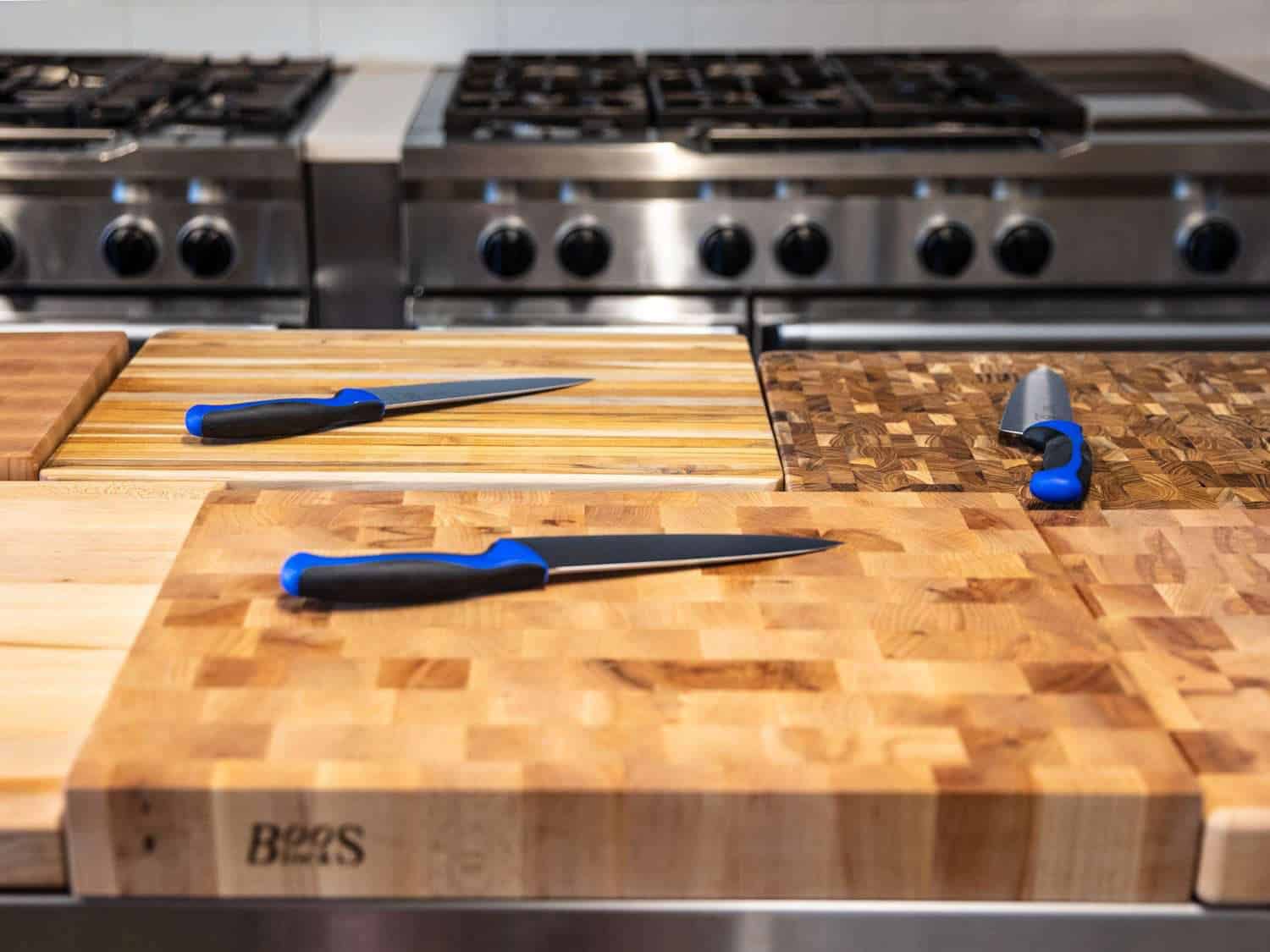
![Is Bamboo Wood Good for Cutting Boards?[8 Reasons Explained] Is Bamboo Wood Good for Cutting Boards?[8 Reasons Explained]](https://houseadorable.com/wp-content/uploads/2023/01/316002766_5887666997938019_9068589372518329358_n.jpg)
![How To Care For Bamboo Cutting Board? [Steps+Tips Explained] How To Care For Bamboo Cutting Board? [Steps+Tips Explained]](https://houseadorable.com/wp-content/uploads/2022/12/Bamboo_Heat_Resistant_1.jpg)